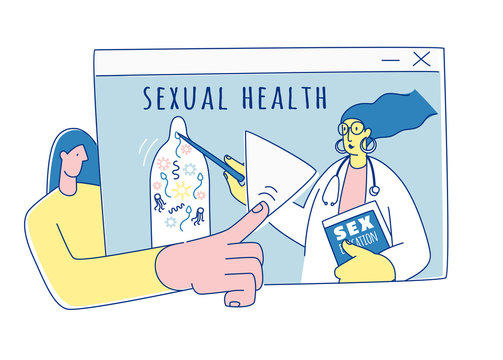The continuing rise in HIV deaths remains an acute health challenge, with nearly 2 million Nigerians reportedly living with HIV, according to Statista. The data also revealed that women are the most affected. Outside of HIV, the soaring numbers underscore the widespread prevalence of sexually transmitted diseases.
A recent UNICEF report also indicates that young women and girls are twice as likely to contract HIV as young men and boys. This poses the fact that women are prone to contracting even other sexually transmitted diseases (STDs) aside from the deadly HIV. Nearly 98,000 adolescent females worldwide tested positive for the virus in 2022, based on the report.
While that number is still nearly half (47%) of HIV infections among that population in 2010, researchers maintain that cultural attitudes, including gender discrimination and socioeconomic factors, play a role in the spread of HIV among women aged 10 and 19 in sub-Saharan Africa.
While these diseases are transmitted mostly through genital penetration, women are also at risk of infection when they engage in sexual foreplay using their hands, as in fingering.
Fingering
Hand stimulation, which involves using the fingers to stimulate a woman’s genitals, is considered among the easiest methods of stimulating the clitoris, necessary for female orgasm. According to a study involving over a thousand women, 18% reported achieving orgasm through vaginal intercourse alone. About 37% stated that clitoral stimulation was necessary for them to reach orgasm, while an additional 36% noted that fingering enhanced their orgasms.
More often than not, fingering may be part of a foreplay or a precursor to other sexual activities. It can provide sexual pleasure to a partner without the risk of pregnancy. For all its pleasure, fingering poses the risk of STIs.
Sexually Transmitted Diseases or Infections
Whichever one is used, both terms describe the same thing: infections that are transmitted during sex. They are usually spread during vaginal, oral, or anal sex, although these do not represent the only means of transmission. Diseases like herpes and HPV are spread by skin-to-skin contact, for example.
Another type or process of STIs is the hand-to-genital method. Although the risk of getting infections from hands to genitals is minimal, infected semen or vaginal fluids on a person’s fingers are likely to transmit sexually transmitted infections through intercourse. Using finger cots or gloves can, however, stymie the chances of contracting an STI.
How can she get an STI from Fingering or Handjob?
According to Medical News Today, vaginal discharge and lubrication carry the same sexually transmitted infections as semen, such as HIV, gonorrhoea, and chlamydia. Hence, a person can contract an STI if they bring their hands into contact with their genitals or mouth after a sexual act involving fingering. The presence of open wounds within the genitals or around the fingers increases the likelihood of contracting a blood-borne STI.
In 2015, a World Health Organisation report indicated that more than 3.7 billion people under 50 have the highly infectious and incurable virus that causes sores around the mouth and genitals. It confirmed that 87 percent of Africans have the virus, which could transmitted when the mouth is into contact with the genitals.
While the chances of contracting STIs through fingering and handjobs are low, women face a higher risk of contracting one, especially in the case of broken skin either within the genitals or on the fingers. Washing and disinfecting hands before engaging in such sexual activities is a solution advocated by medical experts.
Usha Anenga, a specialist in gynaecology, advised that before engaging in fingering or handjobs, there should be proper lubrication to avoid sexually transmitted diseases.
“For males, there is a lower risk of injury from these acts performed as foreplay before penetration. However, women are more prone to sustaining injuries due to the sensitivity and fragility of their genitalia, including the vagina and vulva,” Anenga told Prime Progress.
According to the specialist, fingering or handjobs can be an effective means to arouse women. However, he advised that necessary precautions be taken to avoid STIs. He said, “When proper lubrication is lacking, there is a risk of injuries that may lead to infection. It is essential to ensure proper hand washing is in place to maintain safe sexual intercourse.”
The rise in HIV deaths continues to be a critical health issue in Nigeria, with 2 million people living with HIV, predominantly affecting women. Additionally, sexually transmitted diseases (STDs) are widely prevalent. A UNICEF report highlights that young women and girls are twice as likely to contract HIV compared to their male counterparts, with 98,000 adolescent females testing positive for the virus in 2022. The report suggests that cultural and socioeconomic factors contribute to the higher rates of HIV among females in sub-Saharan Africa.
Fingering or hand stimulation, often part of sexual foreplay, poses risks of sexually transmitted infections (STIs). While the act itself is considered low-risk for STI transmission, improper hygiene or the presence of broken skin can increase vulnerability. Medical experts recommend proper hand washing and the use of lubrication to mitigate risks. Women are more susceptible to sustaining injuries from such activities due to the sensitivity of their genitalia, making precautionary measures essential.
Overall, while non-penetrative sexual practices like fingering are generally safer in terms of avoiding pregnancy, they still carry risks of transmitting STIs if proper hygiene and precautions are not observed.






